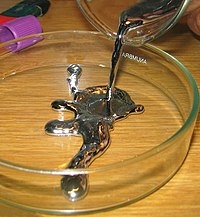
Photo from wikipedia
Aims: To screen heavy metal-tolerant strains from heavy metal-contaminated soil in mining areas and determine the tolerance of the strains to different heavy metals and their removal rates through experiments.… Click to show full abstract
Aims: To screen heavy metal-tolerant strains from heavy metal-contaminated soil in mining areas and determine the tolerance of the strains to different heavy metals and their removal rates through experiments. Methods: Mercury-resistant strain LBA119 was isolated from mercury-contaminated soil samples in Luanchuan County, Henan Province, China. The strain was identified by Gram staining, physiological and biochemical tests, and 16S rDNA sequences. The LBA119 strain showed good resistance and removal rates to heavy metals such as Pb2+, Hg2+, Mn2+, Zn2+, and Cd2+ using tolerance tests under optimal growth conditions. The mercury-resistant strain LBA119 was applied to mercury-contaminated soil to determine the ability of the strain to remove mercury from the soil compared to mercury-contaminated soil without bacterial biomass. Results: Mercury-resistant strain LBA119 is a Gram-positive bacterium that appears as a short rod under scanning electron microscopy, with a single bacterium measuring approximately 0.8 × 1.3 μm. The strain was identified as a Bacillus by Gram staining, physiological and biochemical tests, and 16S rDNA sequence analysis. The strain was highly resistant to mercury, with a minimum inhibitory concentration (MIC) of 32 mg/L for mercury. Under a 10 mg/L mercury environment, the optimal inoculation amount, pH, temperature, and salt concentration of the LBA119 strain were 2%, 7, 30 °C, and 20 g/L, respectively. In the 10 mg/L Hg2+ LB medium, the total removal rate, volatilization rate, and adsorption rate at 36 h were 97.32%, 89.08%, and 8.24%, respectively. According to tolerance tests, the strain showed good resistance to Pb2+, Mn2+, Zn2+, Cd2+, and other heavy metals. When the initial mercury concentration was 50 mg/L and 100 mg/L, compared with the mercury-contaminated soil that contained an LB medium without bacterial biomass, LBA119 inoculation increased 15.54–37.67% after 30 days of culture. Conclusion: This strain shows high bioremediation potential for mercury-contaminated soil.
Journal Title: Toxics
Year Published: 2023
Link to full text (if available)
Share on Social Media: Sign Up to like & get
recommendations!